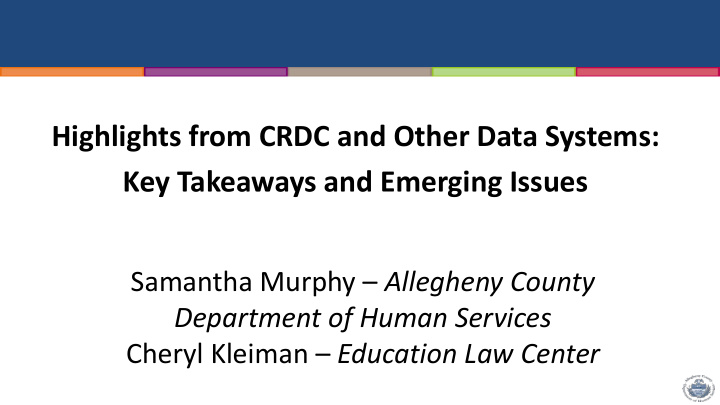



Highlights from CRDC and Other Data Systems: Key Takeaways and Emerging Issues Samantha Murphy – Allegheny County Department of Human Services Cheryl Kleiman – Education Law Center 1
Civil Rights Data Collection: What is it? Collected by U.S. Dept of Education’s Office of Civil Rights • Since 2011, collected from every school, every other school year • A collection of data on key education and civil rights issues in public schools • Uniquely disaggregated - race, gender, disability (IDEA & 504), English-learner Includes o Student enrollment and demographics o Program and curriculum offerings o School Climate (discipline, restraints, bullying, law enforcement) o Staff and Resources 2
How and Why its Used? Part of Multi-Level Strategy to Combat Discrimination – Used in investigations of discrimination complaints – Determine level of compliance to civil rights laws – Inform guidance and policy Important tools for schools, parents, and advocates – Helps identify issues – Data as evidence – Building power through transparency and accountability 3
5
7
HIGH LEVEL DISCIPLINE REPORT Additional Reports • Suspension and Expulsion • School Days Missed Due to OSS • Transfer to Alternative Schools Restraints and Seclusion 8
QUESTIONS TO ASK • Most striking? • Disproportionality? • By race, gender, disability? • Previous year’s data? • Statewide data? • Correlation between funding or policy decisions?
10
Data Sharing with School Districts • MOU I – one way data sharing, the school district to DHS • MOU II – DHS can share data back with school districts – Child Welfare placement, Homelessness, “at risk” flag 11
School Data in DHS’ Data Warehouse 12
Human Service at a DHS Partner District Human Service Involvement, DHS Partner District Prior Involvement (2002 to present) Involved in 2016-17 45% 43% 39% 40% 36% 35% 33% 30% 28% 24% 25% 20% 15% 10% 5% 0% District-wide Elementary School High School 13
Detailed School District Involvement Human Service Involvement by Program Area – District-level 0% 5% 10% 15% 20% 25% 16% Child Welfare 3% 4% Child Welfare Placement 1% 18% Mental Health 12% 2% Drug & Alcohol 1% 4% Homeless & Housing Supports 4% 1% Assisted Housing <1% 20% Public Benefits (SNAP/TANF) 14% 4% Juvenile Probation (Ages 10+) 2% 14
Academic Performance – Chronic Absence Chronic Absence* by Service Type - 2016-17 Involved with Human Services in 2016-17 Never Involved with Human Services All District Students 30% 28% 25% 24% 19% 20% 17% 15% 13% 13% 10% 10% 5% 0% Any Human Service Any DHS Service Child Welfare Mental Health Public Benefits *Students were chronically absent if they missed 10% or more (about 18 days) of days enrolled in school. This includes 15 excused absences, unexcused absences, and out-of-school suspensions.
Responding to national priorities 16
Example: Multi-year comparisons • Examined educational outcomes for youth in Child Welfare placement (24 hour substitute care, foster home, shelter, group home, respite) • Attendance • Includes data from 6 local school districts • Compared 2016-17 findings to 2013-14 • How did school attendance outcomes change for youth post-placement ? • Examined outcomes for 663 students from 2013-14 • Examined outcomes for 695 students from 2016-17 17
Example: Multi-year comparisons Attendance Trends for Youth in Placement, 2013/14 vs. 2016/17 2013/14 (N=663) 2016/17 (N=695) Post-Placement Attendance Improvement 62% 67% Chronic Absence Rate* 38% 31% • * Students were chronically absent if they missed 10% or more of days enrolled in school. • In 2016-17, the chronic absence rate for the 6 partner districts included was 27%. • Compared to 2013-14, the 2016-17 cohort of youth in placement was more likely to have a post- placement improvement to attend, and less likely to be chronically absent. 18
How Data-sharing has been Used • Grants and Proposals – Proposal for school-based mental health units – RFP for innovative usage of school data • Projects – Afterschool program targeting youth with high standardized test scores but poor attendance/GPA • General internal reporting and research – School discipline trends – Racial disproportionality – Geographic disproportionality 19
Themes and Takeaways 1. Discrimination Persists – Discipline, Restraints, Referrals to Law Enforcement – Look at disproportionality as well as raw numbers – Interventions need to be race, gender, and disability specific 2. Limitations of Data – Can be incomplete and inconsistent – More disaggregated than most, but still gaps – View in tandem with other data sources 20
Themes and Takeaways 3. Data Provides Opportunities for Improvement – Be informed – your school, your district, your state – Available to parents, community, and advocates – Regular review by district leadership – models available CHERYL KLEIMAN, ESQ. Education Law Center ckleiman@elc-pa.org 412-258-2124 21
For More Data-Sharing Information: Samantha Murphy, Resource Services Manager and Education Liaison: samantha.murphy@alleghenycounty.us Sanjeev Baidyaroy, Data Analyst: sanjeev.baidyaroy@alleghenycounty.us 22
Recommend
More recommend